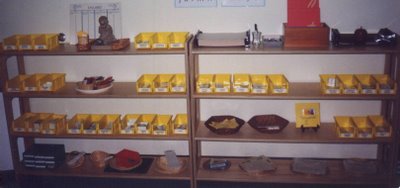This is the time when many schools and homes are setting up for the coming school year. Commonly, classrooms go through several incarnations before teachers and parents hit the combo that’s “just right”. Arranging and rearranging the materials, shelves, tables, and chairs can be a lot of fun, but it’s tempting to always wonder if there’s another, better way that you just haven’t tried yet.
A few simple principles should always be adhered to – they represent the classic Montessori classroom layout. As you can imagine, a preschool classroom layout is slightly different from an elementary one. The differences mirror the changing nature of the elementary child as they move from a wholly concrete environment to a more abstract one.
In a 3-6 classroom, the area closest to the entrance of the room should be, if at all possible, practical life. Sometimes this depends on where the sink is, but since it is the first place that most young children begin working when entering 3-6, it needs to be the first thing they see when entering the room. After that, each of the curricular areas proceeds around the room.
3-6 Classroom Order:
Practical Life
Sensorial
Math
Language
Cultural
It’s easy to see the progression here; sensorial materials are usually the next step after practical life. Since many sensorial materials rely on the decimal system (10 cubes in the pink tower, 10 red rods, etc.), these materials transition nicely to math. Many children recognize numbers before letters, but soon they are ready for language materials. After the acquisition of language comes the ability to learn about culture – biology, history, geography, physical science, art, and music.
In elementary, practical life exercises become integrated with the actual care of the classroom and materials; it’s no longer a separate section. Sensorial materials become the geometry area. Now, language takes the spotlight as the first area of study, and the cultural materials are separated into their own distinct areas.
6-12 Classroom Order:
Language
Math
Geometry
Botany
Zoology
Geography
History
Botany precedes zoology, naturally, since plants are structurally simpler than animals. The category of history now encompasses art, music, health, astronomy, chemistry, physical science, and any other field of scientific study. (The Fundamental Needs of People, a history exercise, provides the key to these curricular areas).
Each area of the classroom also has its own color scheme to help with the organization of materials. They are as follows:
Language – yellow; subcategories of pink, blue, and green for phonetic material
Math – red; subcategories of green (units & thousands), blue (tens), red (hundreds), and red (addition), green (subtraction), yellow (multiplication), and blue (division).
Geometry – blue
Botany – green (naturally!)
Zoology – red (for blood; represents animal kingdom)
Geography – blue
History – black
These colors are used for materials (borders, cardstock, labels) and the containers the materials are put into. There’s some overlap (geometry and geography are both blue), but the materials in those two areas differ enough that it won’t be confusing. Within each area, the work should be arranged in order from easiest to hardest whenever possible. A perfectly color-coordinated elementary language area (click picture to enlarge):

Everything I’ve mentioned so far is the ideal in terms of classroom layout and material color-coding. They are just guidelines, and there is flexibility in actually implementing these guidelines. How your classroom is arranged will depend on the shape and size of the room, the types and number of shelves, the amount of materials, and the amount of money you have to spend. Every classroom – school or home – will be different.
Another note: I don’t mean to imply that a child can only work with the materials in order. Far from it! A child can easily do a practical life work and then move to the cultural area and take out some nomenclature cards. Still, you will notice that a child newest to the 3-6 classroom will spend more time in practical life and sensorial, and possibly need some encouragement (and some one-on-one presentations) to move beyond. In elementary, the children should be working from all areas of the room right from the beginning.
